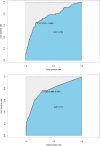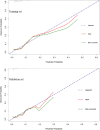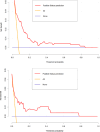Establishment and validation of a predictive nomogram for preoperative deep vein thrombosis in elderly patients with isolated femoral neck fracture
- PMID: 40593178
- PMCID: PMC12217240
- DOI: 10.1038/s41598-025-06305-1
Establishment and validation of a predictive nomogram for preoperative deep vein thrombosis in elderly patients with isolated femoral neck fracture
Abstract
Current assessment of preoperative deep vein thrombosis (DVT) in elderly patients with femoral neck fracture is limited. We aimed to identify independent risk factors for preoperative DVT in patients with femoral neck fracture and to develop and validate a predictive nomogram. Patients diagnosed with femoral neck fracture from October 2014 to April 2019 were retrospectively analyzed. Baseline data, treatment information and laboratory test results were collected, and the occurrence of DVT in the preoperative period was regarded as the study outcome event. Multivariable logistic regression identified independent risk factors associated with a higher incidence of preoperative DVT. The predictive nomogram was constructed based on the analysis results. The stability of the model was further assessed in this study using patients from May 2019 to September 2022 as an external validation set. A total of 921 patients were enrolled in the study, of which 639 were used in the training cohort and the other 282 for the validation cohort. Multivariate analysis revealed age (OR 1.100, 95% CI 1.042-1.162), BMI ≥ 28 (OR 3.969, 95% CI 1.792-8.793), smoking (OR 2.998, 95% CI 1.255-7.165), LDL-C > 3.4 mmol/L (OR 2.628, 95% CI 1.316-5.250), and d-dimer > 0.475 mg/L (OR 3.157, 95% CI 1.565-6.368) were the independent risk factors of preoperative DVT. The concordance index (C-index) of the nomogram were 0.832 in the training set, and the corrected values after internal validation were 0.759. The receiver-operating characteristic (ROC) curve, the calibration curve, the Hosmer-Lemeshow test and the decision curve analysis (DCA) performed well in both the training and validation cohorts. In this study, we developed a personalised predictive nomogram containing five high-risk factors, which can help surgeons stratify the risk of preoperative DVT in elderly patients with femoral necks and guide high-risk patients to ultrasound scans or prophylactic anticoagulation as soon as possible.
Keywords: Femoral neck fracture; Prediction model; Preoperative deep vein thrombosis; Risk factor.
© 2025. The Author(s).
Conflict of interest statement
Declarations. Competing interests: The authors declare no competing interests.
Figures





Similar articles
-
Building and Verifying a Prediction Model for Deep Vein Thrombosis Among Spinal Cord Injury Patients Undergoing Inpatient Rehabilitation.World Neurosurg. 2025 Feb;194:123451. doi: 10.1016/j.wneu.2024.11.034. Epub 2024 Dec 6. World Neurosurg. 2025. PMID: 39571896
-
Analysis of risk factors and prediction model construction of deep vein thrombosis in patients with lumbar degenerative diseases before surgery.Sci Rep. 2025 Jul 18;15(1):26069. doi: 10.1038/s41598-025-10752-1. Sci Rep. 2025. PMID: 40681658 Free PMC article.
-
Risk factors for lower extremity deep vein thrombosis after intertrochanteric fracture of the femur and its response.Medicine (Baltimore). 2025 Jun 27;104(26):e42997. doi: 10.1097/MD.0000000000042997. Medicine (Baltimore). 2025. PMID: 40587689 Free PMC article.
-
Thrombolysis for acute deep vein thrombosis.Cochrane Database Syst Rev. 2016 Nov 10;11(11):CD002783. doi: 10.1002/14651858.CD002783.pub4. Cochrane Database Syst Rev. 2016. Update in: Cochrane Database Syst Rev. 2021 Jan 19;1:CD002783. doi: 10.1002/14651858.CD002783.pub5. PMID: 27830895 Free PMC article. Updated.
-
Warfarin initiation nomograms for venous thromboembolism.Cochrane Database Syst Rev. 2016 Jan 29;2016(1):CD007699. doi: 10.1002/14651858.CD007699.pub3. Cochrane Database Syst Rev. 2016. PMID: 26822633 Free PMC article.
References
Publication types
MeSH terms
LinkOut - more resources
Full Text Sources
Medical
Miscellaneous

